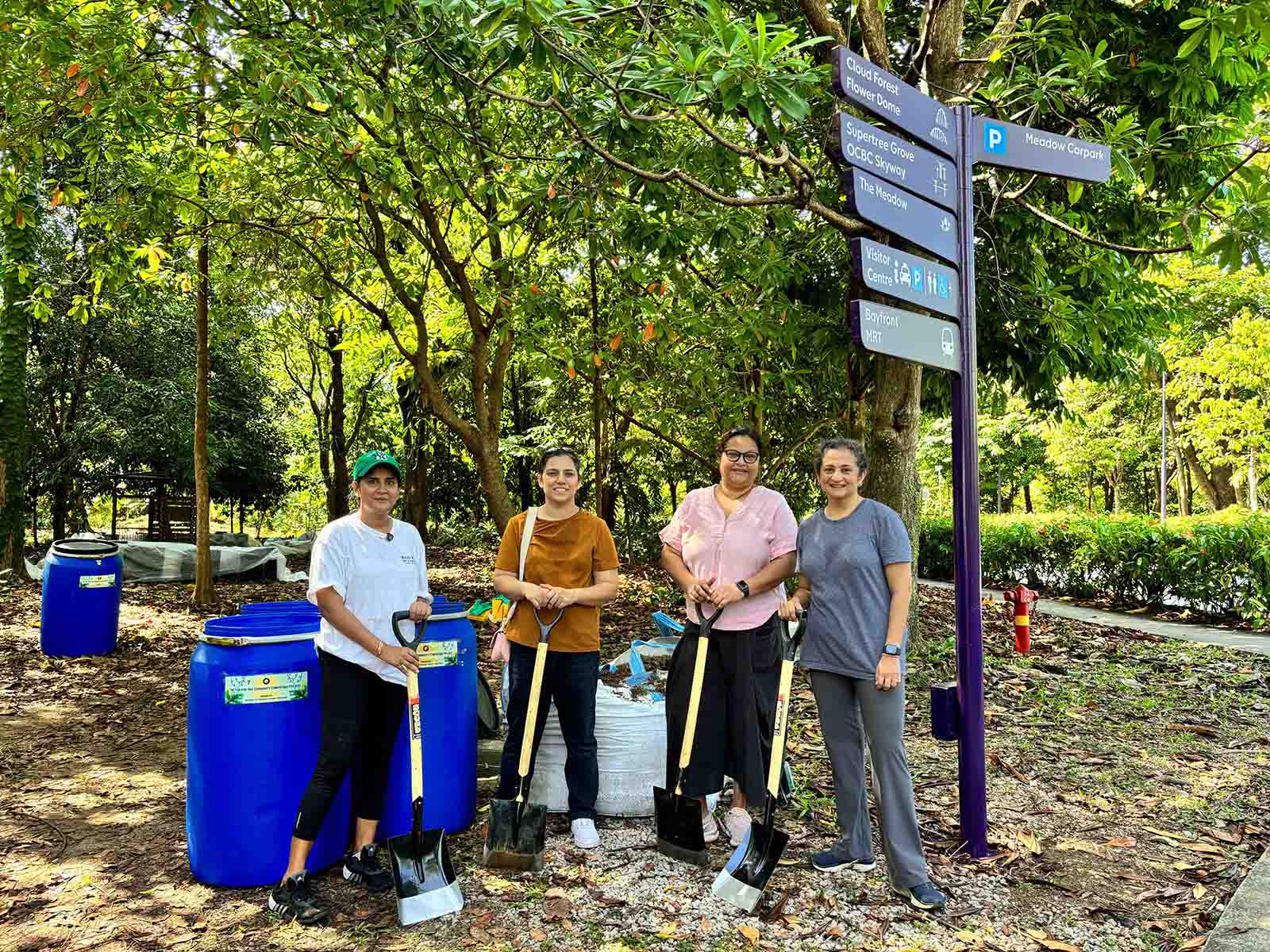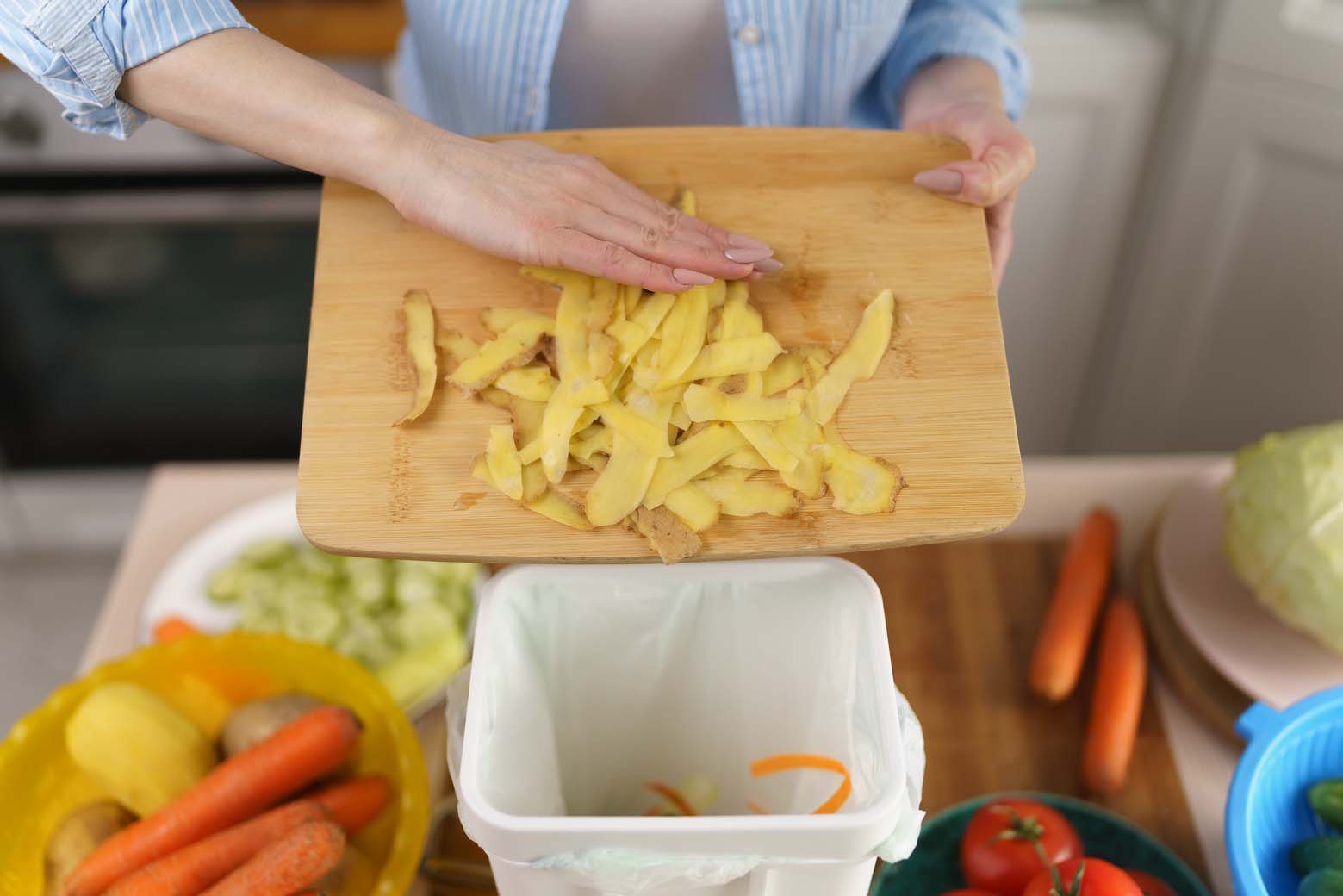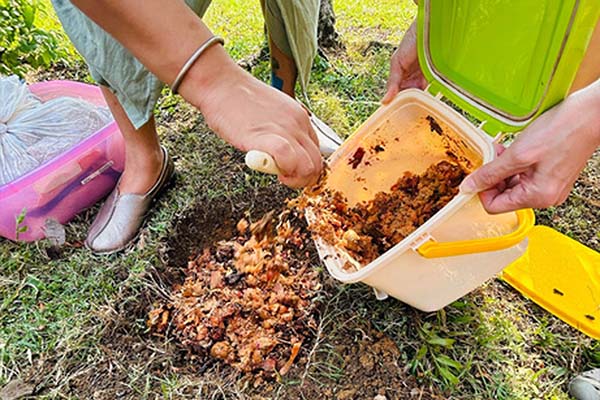



Tanjong Rhu
Community Composting Project Playbook
This playbook serves as a guide for communities interested in replicating the Tanjong Rhu Community Composting Project, a NEA-funded initiative focused on source segregation of food waste using the Bokashi method. It outlines the project's key components, best practices, and lessons learned, offering a roadmap for successful implementation.
Table of Contents
3.1
Project Planning and
Setup
3.2 Implementation
3.3 Monitoring and Evaluation
3.4 Sustainability & Scalability
3.5 Lessons Learned
3.6 Resources
3.7 Conclusion
1. Introduction to the Tanjong Rhu Community Composting Project
The Tanjong Rhu Community
Composting Project is a pioneering pilot study designed to create a
sustainable food waste recycling model within an apartment-style residential
community. By utilizing the Bokashi
composting method, an odorless, space-efficient, and highly effective
approach, the project aimed to overcome the challenges of urban composting
while maximizing community participation.
Supported by the NEA Call
for Ideas Fund and conducted in collaboration with Gardens by the Bay, the initiative emphasized a decentralized, community-driven approach
to food waste management. Gardens by the Bay provided dedicated composting
sites and utilized the nutrient-rich compost generated, reinforcing its
commitment to sustainability and circular economy practices.
Launched on July 1, 2024,
and concluded on December 31, 2024,
the project aligned with Singapore’s
Zero Waste goals, the “30 by 30” food security initiative, and the nation’s
Net-Zero 2050 target. Through active community engagement and
experimentation with Bokashi composting techniques, Rejuvrth explored
innovative ways to regenerate soil,
reduce landfill waste, and enhance urban sustainability.
The ultimate goal of
the project was to develop a scalable,
decentralized, and community-led composting ecosystem that could serve as a
blueprint for managing organic food waste across Singapore.
Bokashi Method Overview:
The Tanjong Rhu Community
Composting Project adopted the Bokashi
composting method as an innovative solution to food waste management in an
urban setting. Unlike traditional composting, Bokashi is an anaerobic fermentation process that
efficiently breaks down food waste, including cooked food, meat, and
dairy—items that are typically difficult to compost. This method was chosen for
its space-efficient, odorless, and
low-maintenance nature, making it ideal for apartment living.
Bokashi composting involves layering food waste with Bokashi bran, which contains beneficial
microbes that accelerate decomposition while preventing foul odors. Once
fermented, the pre-compost is buried in soil or further processed to create
nutrient-rich compost. This approach aligns with Singapore’s sustainability
goals by reducing landfill waste,
enhancing soil health, and promoting a circular economy.
Through this project, Rejuvrth aimed to empower residents with a simple and effective way to recycle food waste,
while also supporting Singapore’s Zero
Waste vision and 30 by 30 food security initiative. The compost produced was utilized at Gardens by
the Bay, closing the loop between food waste generation and sustainable
soil enrichment.
2. Purpose of this Playbook
This Playbook serves as a step-by-step guide for replicating the Bokashi-based community composting model
used for the
Tanjong Rhu Community composting Project in other
residential areas. This playbook provides a structured approach to implementing decentralized food waste
recycling, tailored for urban settings like high-rise apartments.
By following this guide, communities, organizations, and
policymakers can learn how to set up,
manage, and sustain a community-driven composting initiative. The playbook
outlines key components such as stakeholder engagement, logistics, Bokashi
composting techniques, and compost utilization strategies.
With this resource, Rejuvrth aims to empower communities to reduce food waste, enrich soil, and contribute
to Singapore’s Zero Waste and sustainability goals.
3. Initiating
a Community Composting Project in your Neighborhood
3.1 Project
Planning & Setup
Community Engagement:
●
Initial Outreach:
o
Conduct online surveys (google forms, Qualtrics) to assess
community interest and gather feedback.
o
Organize community events, workshops, and info sessions to educate
residents about Bokashi composting.
o
Utilize online platforms (e.g., social media, WhatsApp groups,
community forums) to disseminate information.
o
Collaborate with Residents' Committees (RCs) to leverage existing
community networks.
o
Maintain early and consistent communication to build trust and
encourage participation.
●
Volunteer
Recruitment & Training:
o
Recruit community members as Bokashi Champions to lead the
initiative.
o
Provide training materials covering Bokashi composting basics,
troubleshooting, and community outreach.
o
Conduct hands-on training sessions, including bin setup and waste
management best practices.
o
Develop a mentorship system where experienced volunteers guide
newcomers.
●
Incentive Programs:
o
Offer incentives such as discounts on Bokashi bins, recognition
through community spotlights, and compost give-back programs.
o
Create a volunteer reward system (e.g., certificates, small tokens
of appreciation) to encourage long-term engagement.
Site Selection:
●
Criteria:
o
Choose a location for common bins that is easily accessible to
participants and volunteers.
o
Ensure the site has ample shade to maintain optimal composting
conditions.
o
Proximity to a water source for occasional rinsing and
maintenance.
o
Sufficient space to accommodate multiple composting bins and allow
for expansion.
●
Securing Approval:
o
Work with the Town Council (for HDBs), MCST (for Condos) and NEA
to obtain necessary permissions.
o
Submit a site proposal detailing project benefits, safety
measures, and expected outcomes.
o
Engage with local stakeholders to gain their support and
cooperation.
Procurement:
●
Bokashi Bins:
o
Select durable, airtight bins suitable for urban composting.
o
Identify suppliers and compare costs for bulk purchases.
o
Determine the required number of bins based on projected food
waste volume.
●
Bokashi Bran:
o
Source high-quality Bokashi bran from trusted suppliers.
o
Explore options for bulk purchasing or local production.
o
Educate participants on how to make their own bran using effective
microorganisms.
●
Common Bins:
o
Select large capacity collection bins for weekly emptying of food
waste collected from the households.
o
Gloves, masks, and safety gear for volunteers.
o
Educational signage to reinforce proper composting practices.
Budgeting:
●
Provide a sample budget template including estimated costs for:
o
Bokashi bins and bran.
o
Educational and promotional materials.
o
Volunteer training and incentive programs.
o
Maintenance and contingency funds.
3.2
Implementation
Food Waste Collection:
●
Segregation
Guidelines:
o
Only food scraps, cooked and raw, can be composted (e.g., fruit
peels, vegetable scraps, grains, meat, dairy, small bones).
o
Avoid liquids, large bones, and non-biodegradable items.
o
Use infographics to provide clear visual guidance.
●
Collection System:
o
Designate collection points within the community for easy
drop-off.
o
Establish a structured collection schedule (e.g., weekly or
biweekly pickups).
o
Establish a two-step collection system: 1. Segregation of food waste at home using
Bokashi Method. 2. Weekly emptying of said food waste from each household in the community bins.
●
Hygiene & Pest
Control:
o
Ensure bins are sealed tightly to prevent odours and pests.
o
Conduct regular cleaning and maintenance of bins and collection
points.
o
Use effective microorganisms (EM) to enhance fermentation and
reduce potential issues.
Bokashi Composting Process:
●
Step-by-Step Guide:
o
Layer food waste with Bokashi bran inside an airtight bin.
o
Press down to remove air pockets and seal the bin tightly.
o
Continue layering until the day of the weekly collection, where
the food waste gets emptied into the community bins.
o
Community bins, when full, will be sealed for two weeks to aid
fermentation of the food waste.
●
Troubleshooting:
o
Address common issues such as strong odours (add more Bokashi
bran) or excess liquid (drain frequently).
o
Identify signs of improper fermentation and provide corrective
actions.
●
Fermented Bokashi Mix
(Pre-Compost):
o
After fermentation, the mix is partially broken down but not yet
soil-ready.
o
Store in a cool, shaded area until ready for the next composting
phase.
Compost Maturation:
●
Second Stage
Composting:
o
Mix the fermented Bokashi waste with soil or bury it in a
designated composting area.
o
Allow 4-6 weeks for the organic material to fully decompose into
nutrient-rich compost.
●
Compost Utilization:
o
Use the finished compost in community gardens, parks, and residential
landscapes.
o
Offer compost back to participants to encourage continued
engagement.
o
Integrate with urban farming projects to support local food
security initiatives.
3.3
Monitoring &
Evaluation
Data Collection: To measure the success of the
Tanjong Rhu Community Composting Project, key metrics must be tracked
throughout its implementation. These include:
●
Amount of
food waste diverted from landfills.
●
Community
participation rate, including the number of households involved.
●
Compost
quality assessment, including nutrient levels and usability.
●
Frequency
and consistency of participation.
●
Feedback
from community members regarding ease of use and satisfaction with the program.
Monitoring Tools: To gather accurate data, a
combination of qualitative and quantitative tools will be used:
●
Weigh
scales to measure the total food waste collected and compost produced.
●
Surveys
and feedback forms distributed to participants.
●
Observation
logs maintained by volunteers to track composting progress and potential
issues.
●
Digital
tracking systems (e.g., spreadsheets or apps) for recording waste diversion
data.
Evaluation Framework: The collected data will be
analyzed to determine:
●
The
environmental impact, particularly in terms of waste reduction and soil
enrichment.
●
The level
of community engagement and overall satisfaction.
●
Areas for
improvement, including better outreach methods, training adjustments, and
process optimizations.
●
Long-term
feasibility and scalability of the composting model for other communities.
3.4
Sustainability
& Scalability
Long-Term Maintenance: To ensure the sustainability of
the project beyond its pilot phase, the following strategies will be employed:
●
Continuous
volunteer recruitment and training sessions to maintain engagement.
●
Securing
ongoing funding through grants, sponsorships, or crowdfunding initiatives.
●
Encouraging
community ownership by forming local composting committees to oversee
operations.
Scaling Up: Expanding the project to new
locations requires a structured approach:
●
Identifying
interested communities and providing them with training workshops.
●
Collaborating
with local organizations, businesses, and government agencies to secure
necessary resources.
●
Adapting
the model to suit different residential settings (e.g., HDBs, condominiums,
landed properties).
Partnerships: Collaborations with various
stakeholders can enhance the project’s impact:
●
Government
agencies such as NEA for policy support and funding opportunities.
●
Schools
and educational institutions to introduce composting into curriculums.
●
Local
businesses to support initiatives through CSR programs.
3.5
Lessons Learned
Challenges & Solutions:
●
Challenge: Initial resistance from
residents due to misconceptions about composting.
o
Solution: Conducting interactive workshops
to educate the community on Bokashi’s benefits.
●
Challenge: Managing odors and pests in a
dense urban environment.
o
Solution: Proper bin placement, regular
maintenance, and use of effective microorganisms (EMs).
●
Challenge: Sustaining long-term engagement
after the initial enthusiasm wanes.
o
Solution: Implementing incentive programs,
recognition events, and community feedback loops.
Best Practices:
●
Engaging
the community early and maintaining transparent communication.
●
Using
simple, visual educational materials to explain the Bokashi method.
●
Regularly
monitoring and addressing concerns to ensure smooth operation.
3.6
Resources
Contact Information: For more information, reach out
to:
●
Rejuvrth
Team: https://rejuvrth.org/contact-us.php
●
National
Environment Agency (NEA): nea.gov.sg
●
Gardens
by the Bay: https://www.gardensbythebay.com.sg/
Links to Useful Resources:
●
NEA’s
guidelines on food waste management
●
Food Waste Segregation at
home using the Bokashi Method
●
The Tanjong Rhu Community Composting
Project
3.7
Conclusion
The Tanjong Rhu Community Composting Project
has demonstrated that a decentralized, community-driven approach to food waste
management is both feasible and impactful. By using the Bokashi method, the
project has successfully minimized food waste, engaged the community, and
contributed to urban sustainability. We encourage other communities to adopt
this model and work towards a circular, zero-waste future.



